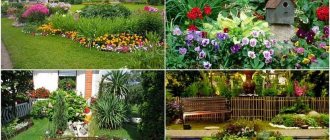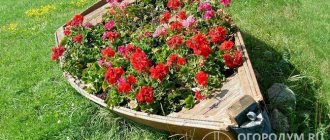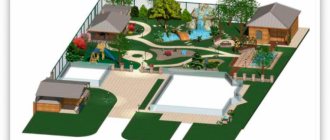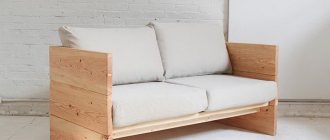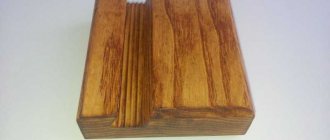An Alpine slide is a good option for decorating a local area in the private sector. The finished decoration gives the area a touch of brightness and chic, emphasizing the coziness and pleasant atmosphere. This facility requires extensive preparation before it can be installed. Therefore, the first stage of organization is creating a project and sketching sketches.
Variety of flowering plants in the rock garden Source deskgram.net
Conifers are a good choice for plantings Source pinterest.ca
Choosing a location for an alpine slide
Preparatory work, naturally, does not begin with the selection of stones or available materials. The first step in making a rock garden is to select the optimal location for it. The slide will not only effectively improve the landscape, but will also help in the rational planning of the site - it can be built, for example, on a not too fertile piece of land.
Perhaps the only place where it is not recommended to place an alpine slide is the area near the fence. Firstly, because the place of the rock garden should be open (as in the mountains), and secondly, a man-made fence somehow does not harmonize with the word “natural”, namely naturalness (at least in the choice of site and plants) is the most important property of an alpine slide.
The size of the alpine slide depends on the capabilities on site. To get a good effect, it should not be too small. Plan for at least 10 m² of space in your dacha or garden area, preferably in the sun or partial shade. Rock gardens are especially good on sunny hillsides. But, of course, not every site is located in such a place.
General view of an established rock garden
Designers rarely use overly elongated areas, since it is not always possible to correctly place plants on them and implement all the planned design options. The optimal shape of a rock garden would be a rectangle or trapezoid with an aspect ratio of no more than 2 to 3. Although, of course, a rock garden should not have any rigid boundaries, it should be fit into the design of a summer cottage or garden as naturally as possible.
Typical vegetation is low, ground cover plants or dwarf shrubs, which are adapted to the extreme conditions of the mountains due to their compact size and slow growth. Hairy stems protect against dehydration and strong temperature fluctuations. They create a unique look for the rock garden, which in turn enriches every garden like a jewel.
Not every place in the garden is suitable for an alpine slide, since it will only really flourish in the light. A partially shaded location is also acceptable if the plants for planting are chosen accordingly. A place in complete shade, for example at home, is not suitable for arranging a rock garden.
As a rule, plants for a rock garden are selected that are not afraid of the wind (which, in fact, is constantly observed in the mountains), and are unpretentious in themselves, so summer residents and gardeners do not need to take any protective measures to fence off the area with a hill from the winds and drafts.
The soil should be dry and well drained. Loamy soil is unsuitable for rock gardens, as it often causes waterlogging, which is generally not tolerated by mountain plants sensitive to such conditions. Therefore, it is advisable to organize good drainage in the form of a stone bottom for the future alpine slide. The future site must be cleared of any weeds and all roots that are in the soil.
Alpine slide on the slope
If rabbit or chicken wire is laid in the soil, this will prevent the appearance of mice and voles in the rock garden, which love to make their holes under stones.
Any rock garden to one degree or another needs a drainage system . It will have to be done in any case, since it is strongly recommended to both prevent soil from entering the alpine hill from the site, and the penetration of excess moisture back from the hill into the garden (water can accumulate in the lower layers of the rock garden after each watering).
Czech rock
For drainage, pour the so-called at the bottom of the pit. "pillow". This is a layer of stones, broken bricks, crushed stone, large pebbles or limestone at the height of the first stone tier. Next, it is recommended to add a permeable layer of sand on the pebbles. It will prevent garden soil from getting into the drain and clogging it.
Then comes the next, narrower layer of drainage made of small pebbles. If the soil is rich in nutrients, it should be mixed with sand or limestone, as mountain plants prefer poor soil.
Stages of creating a rock garden
From the area allocated for the rock garden, a layer of soil up to 30 cm is removed, the roots of weeds are cleared, and a crushed stone or gravel cushion is placed in this place.
Instead of crushed stone, you can use broken bricks and fragments of building blocks. This will be drainage that will not prevent moisture stagnation. This stage is important because the vegetation in the rock garden is mostly drought-resistant and does not tolerate waterlogging of the soil.
The next stage is modeling the mountain landscape.
An embankment is made from small stones, crushed stone and earth. The largest stone blocks are placed on it first, and the space between them is filled with smaller parts. During the process of laying stones, you need to inspect the slide from time to time from a certain distance in order to make changes in time if necessary.
Advice. It is recommended to dig some boulders into the soil to a third of their height, or add soil under them. This technique contributes to a more natural, natural landscape.
The structure is spilled with water and left for two weeks. During this time, the soil will shrink under the weight of the blocks, and the hill will be ready for planting.
Laying and design
Creating a rock garden for experienced amateur gardeners will be an easy undertaking. However, if you are new to this business, then you should get advice and advice from experts. Ultimately, a professional gardener or computer program will help you design your rock garden correctly.
But many amateurs or simply owners of dachas have their own ideas, which they can also quite easily implement. However, every gardener should at least create a sketch of the future alpine slide with details and a general planting plan. In addition, it is necessary to select and purchase all suitable plants in advance.
Filling scheme
Once the area has been cleaned and prepared and, if necessary, equipped with rodent control netting, the rough work can begin. Such as: adding earthen embankments, watercourses for possible streams or waterfalls, placing large stone blocks or boulders.
The watercourse itself must be designed and installed first due to the complex layout and possible electrical connections. This will allow you to easily lay or lay out electrical cables.
First, mark the area by driving pegs around the perimeter. In the case of creating terraces or slopes with different levels of elevation, they are marked on pegs using ropes. Next, if necessary, a foundation is prepared for the slide, a foundation pit is dug, drainage is filled in, etc. Then you should lay and compact a layer of sand or large stone chips (to avoid shrinkage), on top of which decorative stones, pebbles or shell rock are placed, which will be visible to guests and visitors.
The use of dolomite and other brittle minerals is not recommended. It is recommended to give preference to durable rocks.
Scheme of a vegetable rock garden
Then the design of the upper and middle levels of the rock garden is carried out. Here it is advisable to place all structural elements in such a way that their stability is maximized (for safety reasons). This issue will be especially relevant on personal plots with slopes, as well as when using stones and other structures with large dimensions.
Perhaps, to strengthen them, some additional means will be needed, for example, metal parts, which will subsequently need to be hidden from the eyes of observers, so as not to spoil the aesthetics of the rocky garden. Removing such improvised fasteners is relatively simple - it is, for example, covered with crushed stone, tuff or any natural material.
Alpine slide diagram
Subsequently, steps or open spaces with stone slabs to stand on should be created. In some cases, the creators of rock gardens make sure that access is provided to all areas of the mini-garden - from the lowest point to the top. For these purposes, it is recommended to use a material that is excessively porous.
It is recommended to fill the cracks between the stones with small pebbles or fill them with putty solution. This way, a sudden downpour will not undermine the stepped stones. In this case, you need to take into account the color balance - if necessary, add dye to the solution.
However, adding dye can have a completely different effect: depending on the design style of the rock garden, you can create the illusion of a water stream, green meadow, etc. It is clear that the design style of an alpine hill should be as natural as possible, but near the border areas various deviations from the canon are possible.
Marking
The next step is to transfer the diagram to the selected area: this can be done using pegs and rope. A pit is dug according to the markings: if the soil is sandy, then 30 cm deep, if the soil is oily, then deeper. The bottom is compacted, a metal mesh and geotextile fabric are laid on it.
Note!
- How to make a hot smoked smokehouse - 75 photos of the best ideas and step-by-step instructions
Molds for paving slabs - easy instructions on how to make them yourself (80 photo ideas)
Feeder for chickens - ideas, description of construction and features of creating feeders from scrap materials
Planting
Planting process
Anyone who carefully and in advance selects plants for planting will be satisfied with their rapid growth and will save themselves from the unnecessary hassle of caring for them. The choice should take into account the degree of illumination of the site and its soil conditions . Here optimal conditions for plant growth will be provided. In the end, there are no alpine hills that are planted with monotonous deciduous plants.
A rock garden, which will be filled mainly with high-mountain, alpine plants, will look especially luxurious. Evergreen and coniferous dwarf shrubs will complement the image, as they are very beautiful even in winter, under the snow and grow very slowly.
Grasses, herbaceous annuals, perennials or tuberous plants should be among relatively tall plants such as thyme or lavender. Ground cover plants are important for maintaining an attractive appearance throughout the genus. These can be aubrieta, sedum
Season matters
You need to take care of the wintering of the rock garden in advance. Those plants that are not adapted to our climate and are unlikely to survive the winter will have to be dug up and transplanted into tubs. Other plants are wrapped in agrofibre - this type of material prevents damping off.
The shrub called “ephedra” must be covered entirely and tied with braid.
Snow will save the hill from severe frosts and wind. It is also advisable to place shields around the perimeter, which can serve as sheets of plywood, slate or parts of old furniture. The reservoir at the rock garden must be drained or several rubber balls thrown into it - they will take the pressure of the ice. The pump with hoses must be removed and stored in the country house.
When the winter storms are behind us, it’s time to prepare the “paradise” near your home for the new season. From the beginning of spring, it will be necessary to eliminate the consequences of snowfalls, blizzards and melt water.
- Some plants, unfortunately, die. The stones may have slipped, and the entire round hill is covered with the rotten remains of the former flower garden. First of all, you need to work with a rake, removing rotten leaves. Then put the boulders in place, add fresh soil and gravel, and then plant the plants that overwintered in the warmth and add new ones.
Suitable plants
Cyclamen Kos
Excellent for a rock garden - evergreens and hardy plants, as well as annuals. Even perennials such as trefoils or awl-shaped phlox, conifers and shrubs such as lavender and blue lavender work well between the stones. Alpine plants such as primroses and carnations provide a special mountain atmosphere. Your choice of plants can be stopped at:
Perennials
- gentians
- edelweiss
- stone roses
- saxifrage
- cyclamen
- primroses
- immortelle
- irises
- bells
- various ferns or succulents
Shrubs or trees
- mountain dwarf pine
- spruce
- creeping juniper
- small gorse
- bells
Juniper creeping
Herbs
- bluegrass
- rushnik
- xerophyllum durable
Meadow bluegrass lawn
Bulbous and tuberous plants
- wild tulips
- crocuses
- low daffodils
- squill
- grape hyacinth
Grape hyacinth
In general, the rock garden is designed according to fairly simple principles, and it is not at all necessary to follow a complete repetition of the mountain landscape (since in fact it is quite sparse). Typically, there are several main trends in the design of rocky hills:
- highlighting the center of the composition
- perimeter design
- chaotic “population” of a hill with plants without any hierarchy
Focusing on the center of the composition is the most common way to decorate a slide. It is easier to find some attractive object that will give the desired accent effect than to use any other design technique.
In this case, the brightest plants are planted closer to the center (or to the highest point) of the rock garden. They can be either tall or short, the main thing is their spectacular appearance. For example, it may be appropriate to use plants with foliage of unusual color or shape. Sometimes large plants or even bushes may be located in the center, which will be visible from a great distance.
Drawing attention to the perimeter of the composition is used less often. This is the opposite principle, which makes sense if some kind of functional part is located in the center of the rock garden (for example, a bench, gazebo or barbecue). And the rock garden itself in this case does not have a pronounced top, or even looks like a concave bowl.
Here it’s the other way around – the border of the site stands out. The selection of plants in this case will differ from that discussed earlier. Firstly, in this case it is advisable to choose the shortest ground covers. In this case, it would be natural to use different types of moss. After a few years of growth, moss perfectly imitates any natural landscape.
Secondly, planting plants around the perimeter should not be in the nature of “fencing” the rock garden, much less creating some kind of wall - everything should be as open to view as possible. That is, if the hill is designed in this way, you need to plant plants of medium height on the border, no more than 50-80 cm in height, with trunks with a small thickness. These can be miniature conifers or various subshrubs (such as iberis, barberry, azaleas, mixtures of phlox of various shades, etc.)
You can give free rein to your imagination and see how various exotic plants will look in this role: cotoneaster, boxwood, dwarf pine or thuja and others, using the example of one specimen, and, if everything goes well, plant several of them. Another option is to use bright plants, such as bergenia or marigolds, to decorate the perimeter. In any case, see what works best for the role of a “natural fence” in the first years of the slide’s existence, so that you can then make some adjustments to the design.
The most important nuance in this design method is to create sufficient uniformity inside the rock garden with a clearly visible boundary. This implies more or less evenly planting ground cover plants in its central part.
If the site is filled chaotically, planting can be arbitrary, but it is also recommended that several requirements be met:
- natural plant appearance
- compliance with compatibility rules
However, cases of incompatibility of plants for rock gardens are very rare, since they all survive in fairly harsh conditions, and given that they have little soil, the exchange of substances with it is quite poor, that is, if there is any competition among plants, then only for above ground levels.
Possible choice of plants for a rock garden
Once you have decided on your plants, you should first arrange the pots on the surface of the mound for preliminary evaluation and “trying on”.
Make sure plants are harmonized in height and color and respect the lateral tendency of plants to spread at intervals. Then dig a planting hole at the designated location using a hand shovel.
Place the plant only 2/3 of the way up into the hole and optionally place a name tag next to it. Fill the root area with soil (to which you can add peat) and press down slightly. After you have planted all the plants, water the hill generously.
In some cases, it is permissible to include exotic plants in the design of the slide, which, although not suitable for the slide in terms of habitat, have an appearance consistent with the general design concept. These can even be heat-loving plants, temporarily installed on a hill in pots or flowerpots. Naturally, the container installed on the hill must be camouflaged in some way, and the plants must be put away in a warm room for the winter.
Ideas for a rock garden
There is no specific template for arranging a rock garden, so it is impossible to find two identical flower beds. The creation of each of them is carried out based on their terrain, the area of the garden plot, the availability of stones, as well as creative ideas.
Rock garden with coniferous plants
Low-growing, creeping and dwarf forms of coniferous plants seem to be created for alpine hills. Spruces, pines, junipers and thujas thrive on rocky and sandy soil; most of them are resistant to low temperatures. One of the main advantages of these plants is their small annual growth, which makes caring for the hill much easier.
Junipers and thuja in the foreground
Erect junipers and thujas are planted in the background so that their crown does not cover the central part of the composition, and creeping species are placed on the slopes of the hill. If flowering plants are used together with conifers, it is important to maintain moderation and not overload the flower garden with them. This is the case when abundant flowering can distract from the main theme of the composition.
Rock garden with dry stream
The rocky bed of a dry stream can become the central, dominant element of an alpine hill. A narrow strip of pebbles or crushed stone is laid out, and the edges of the improvised shore are outlined with boulders of different sizes. Vegetation typical for reservoirs is planted between the stones: swimsuit, arrowhead, cattail, iris.
If the dry stream is quite long, the slide is arranged at its source. The stream seems to originate at the top of the rock garden and flow down the steepest slope. It is important to choose stones to simulate a flow, the color of which is different from the boulders of the rock garden, so that it stands out against the general background.
Rock garden with pond
A rocky slide located next to an artificial pond looks very natural. It is made on one side of the reservoir so that it does not cover the water surface. The edges of the rock garden can cover the shoreline of the pond, and then the rocky shore will be reflected in it, as in a mirror.
If you install a pump and run a hose to the top of the slide, you will get a waterfall. Stone steps are arranged for it, along which water flows into an artificial lake. In cases where it is not possible to make a rock garden with a pond, you can install a watering installation with a sprinkler between the stones. It will perform two functions: to be part of the design and to refresh the air rising from the stones heated in the sun on a hot day.
If there are very few stones
The basis of a rock garden can be just 2-3 large boulders. They are located on a flat, open area covered with gravel or fine crushed stone. Since there are few stones, it is especially important that they are of the same type. Very little vegetation is used in such a composition, preferably with evergreen foliage.
Small gabions look original in rock gardens with a flat landscape. They are made in the form of a box, ball, hemisphere. Between the stones in the upper part of the gabion, pots with unpretentious herbs are placed, which enhance the impression of the naturalness of the composition.
Advice. Weeds that have made their way through the gravel are very difficult to remove. To get rid of them, the site is first cleared of vegetation, covered with sand and covered with geotextiles. Only after this is it covered with gravel. Plants are planted in slits made in the material.
Care
A planted alpine hill needs less attention than a regular garden or flower bed, which is ideal for amateur gardeners with limited time resources. Weed infestation is usually prevented by placing gravel around the mound and using non-greasy soils. Or they are promptly deleted.
Various infections, bacterial infections, rot, which are caused by high humidity, are prevented by sufficiently good drainage. Also, rock gardens rarely need fertilizing and fertilizers, and mountain plants rarely need to be pruned due to their very slow growth. However, very eroded soil should be replaced.
Watering is only necessary during the particularly hot, dry summer months. Seeds of other plants should be regularly prevented from getting onto the hill and their further settlement in the rock garden. Because mountain plants grow slowly, they are quickly overwhelmed by other, more active crops.
A real gem of the garden
Various slugs, snails and other pests must also be strictly removed. Mosses must be dealt with in the same way. After removal, loosening the soil with sand or limestone helps against them.
An alpine slide with natural stones is suitable for both large and small gardens. Rolling hills look especially beautiful, and low, colorful carpets of plants will look great among dwarf conifers. A pond or stream can also be combined into a common composition with a rock garden. But they must be of appropriate sizes. Remember that in rock gardens, paths or places where you can walk are laid with flat stones or fine gravel. Driftwood or other decorative objects can add variety and set the necessary accents.
Amazing decoration in front of the house facade
You can also place containers or pots of seasonal plants on flat rocks. Depending on the differences in the flowering season of trees and grasses. Of course, the shape and size of the stones are primarily important for an alpine slide. However, in everything you should observe moderation and adhere to style. Take an example from nature.
Planning
Before you start work, decide on the size of the slide and plan it by drawing it. You need to calculate how many and what kind of stones you will need, what plants and in what place of the hill you plan to plant them.
You can also do the opposite: if you already have the material, in particular stones, plan the slide based on their availability.
General recommendation: if you are creating a slide in a small summer cottage, make it low - 0.5-0.8 meters in two or three tiers. The main design rule is to avoid symmetry.
Selection of stones
Ideally, the soil will be heterogeneous. The condition of the soil is of great importance. The effect of maximum naturalness is important. The slide must be both wet and dry. This requires constant monitoring of her condition, but it is worth it.
Mix heavy soil and sand with limestone or chalk. Remember that in nature things are rarely symmetrical, so place the stones so that they look natural. They should not be placed in a line or in the same direction!
Create a non-symmetrical, asymmetrical picture so that everything looks natural and atmospheric.
Large boulders, sandstones, shale and pebbles are ideal
Large boulders, sandstones, shale and pebbles are ideal. Choose only one type of rock. Even in shape, round or broken, some uniformity should be maintained. This way the rocks and cliffs will look harmonious. Large stones should be buried. You need to do this by about 1/3. Regardless of whether it is diabase, gneiss, limestone, granite or schist - anyone who wants to build an alpine hill can use almost any stone.
At the foot of large boulders it is necessary to place medium-sized stones, but this is not a dogma - sometimes it is enough to sprinkle the soil around with fine or medium-sized crushed stone.
When choosing the type of rock for your slide, it is also important to consider the weather conditions in the respective regions. Typically, granite, quartzite and basalt are used due to typical weather and temperature fluctuations in the mid-climate. If someone follows these criteria when creating a rock garden, he will be able to admire the fruits of his labor for a long time.
Compact mini rock garden
What it is?
Alpine slide is a composition in landscape design that demonstrates a piece of the mountain landscape.
Alpine slides consist of stones and flowers and can be supplemented with shrubs, garden decorative elements, even waterfalls. There is another type of similar decoration in the landscape - rockery. But unlike a slide, it is flat. Creating a rock garden requires elevation and descent - that's why it is called a slide.
In the photo there is a rock garden on the site
Pond or stream
It is important that there is enough space. If possible, use round stones to design a miniature pond. The pond should also look as natural as possible. It is better not to use plastic containers whose edges are clearly visible.
Remember that a mountain garden stands and does not fall over with the right plants. As a rule, “less is often more.” Don't choose too many different plants. It is better to use several types or varieties over a large area. The same plants in different places on a hill can look beautiful and beneficial. It is also important that something is always blooming.
An example of a rock garden combined with a pond and a waterfall. Note the rounded shape of the stones
Don't shy away from the green color between the stones. The selection of plants should be made from the same row as for the design of a regular slide. Suitable for the alpine landscape : cinquefoil, gentian, heather, carnation, fern. Many mountain plants are widely available for sale, and you can get some yourself.
They are easy to care for, undemanding, easy to get along with and are content with a small amount of nutrients. And the washed gravel that fills the gaps between the pebbles will give the alpine garden a well-rounded, beautiful and natural atmosphere.
Alpine slide suitable for every site
An important factor is the uneven surface and favorable slope. Especially large plants look good between stones. Plants should be chosen so that at least one always blooms. Proper soil is vital for good plant development.
Varieties
Rock gardens differ in their relief; before starting to create a picturesque area, you need to take into account the landscape features of the local area or park area.
| View | Peculiarities | Recommendations | |
| 1 | mountain wall | Used in the construction of terraced slopes. Flowers and creeping junipers are planted in niches and recesses left in the stonework and filled with soil. | After creation, the wall is watered generously from a spray bottle until the plants take root. |
| 2 | rocky hill | Small stones are placed at the base of the embankment, the top is created from large fragments, and alpine plants are planted | A slide of boulders and layered stones is combined with paved paths and lawns |
| 3 | Gorge in the mountains | In a small ditch or hollow, stones of different heights are laid out along the slopes, and plants are planted between them. | The landscape composition is suitable for areas with natural ravine terrain and two slopes. To strengthen the ravine, boulders are dug into the ground |
| 4 | mountain valley | Stones are buried three-quarters of the way into the ground, paths are laid, a grass carpet is created, and shrubs are planted. | An abundance of herbs and flowers can be complemented by a fountain or small pond |
| 5 | rock cliff | They recreate the breaks in the mountainous terrain with the help of stone fragments, the cliff is planted with crassula, creeping plants | Work begins at the base of the slope, the boulders are pressed tightly together |
| 6 | Mountain Creek | The bottom of the stream is covered with river stones, pellets are laid along the banks, and moisture-loving plants are planted. | Ferns with wide feathery leaves planted near a stream create the effect of wild nature. |
| 7 | Alpine garden | The garden is laid out on an inclined or flat surface, using a minimum of stones | The emphasis is on shrubs and bright plants |
| 8 | Japanese motives | They create the appearance of a collapsed rock, the picturesque area is decorated with basalt, tuff, the area at the base is decorated with perlite, fine gravel | The style of plants in gray, yellow-brown shades, muted red colors, and dwarf shrubs of asymmetrical shape are emphasized |
| 9 | Mini rock garden | A hole in a large trunk, a ceramic container, a basin are filled with earth, small stones, sedums, grains, and armeria are planted | Pre-make water drainage and drainage |
conclusions
An alpine slide is suitable for every site! An important factor is the uneven surface and favorable slope. Especially large plants look good between stones. Plants should be chosen so that at least one always blooms.
Proper soil is vital for good plant development. The alpine slide should not be too dry, but slightly moist. Ground cover plants placed between bulbous or small trees around a small pond will create perfect harmony. And birds and other small animals will feel comfortable there.
Recommendations for Beginners
To get a chic decoration in the form of a flower-stone composition for your site, you must adhere to the following recommendations:
- conditionally, you need to divide the hill into sectors in which there is room for a flat part, scree, rock and ascent;
- for best perception, it is better to use no more than four spots of different sizes against a green background;
- Do not use factory decorations.
Each owner gets his own special rock garden, each with its own unique twist. Even the most unexpected things can come in handy when working with it. For example, you can grow flower seedlings in egg trays and then plant them in the ground.
At first, the rock garden will need to add new soil and constantly strengthen the stones. The soil must be poured evenly and compacted after each watering or rain.
Plants also require attention. Do not forget about timely watering, cutting off dried flowers and leaves.
You can fertilize the plant several times over the summer, but be careful with nitrogen fertilizers. They have an excessive effect on the growth rate of plants, which is not entirely good under composition conditions. Overfeeding plants will result in unkempt overgrowths.
It is better to water the rock garden using a sprayer to minimize soil erosion. It would be a good idea to check the stones for strength - they should not wobble. If necessary, insect repellents can be used and diseased plants can be removed immediately. The soil at the site of the diseased plant will also have to be replaced.
Interesting landscape design options
Park areas are rarely complete without the dazzling beauty of a rock garden or rock garden. It’s no wonder that many people want to have such beauty before their eyes all the time. It is unlikely that anything could be fresher, more beautiful and charming than such a composition on a personal plot.
Below are interesting examples of rock gardens and rock gardens for inspiration, because work on each site will require a unique project.
An example of a classic rockery in the Japanese style. A minimum of plants among the lifeless stone landscape.
Preparing the territory
It is necessary to remove the outer layer of turf, the depth of which is at least 300 mm. To form the bottom layer - this is 100 mm - you will need materials such as slag, crushed brick and gravel.
A second layer is laid on top, which includes sand consisting of large fractions - from 50 to 100 mm. Each layer should be watered. Next you will need an earthen mixture, which can be purchased in specialized stores or made with your own hands. The growth, development and flowering of all vegetation that will be planted on the hill directly depends on the quality of the soil.
To make a mixture of soil with your own hands, you need to mix clay with peat in a ratio of 3/1, and then add a sand-gravel mixture in a ratio of 5/1.
All components of the soil must be clean, so you can avoid excessive growth of weeds on your alpine hill. The prepared or purchased earthen mixture must be poured onto a previously prepared drainage system and formed into a small hill about a meter high, although an alpine hill can be much higher.
